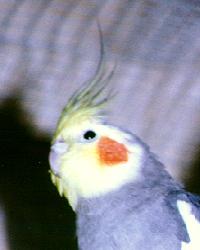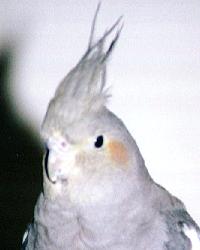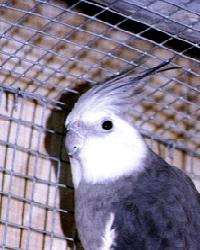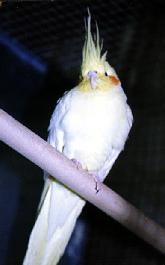 |
 |
| Adult male normal grey | Adult female normal grey |
There are several methods for telling the gender of a cockatiel, depending on the age and color of the bird.
Facial mask:
For normal
greys, cinnamons, and pearls, adult males and adult females are
easy to tell apart. The male bird will have a bright yellow
facial mask that covers most of the face, surrounding the orange
cheek patch. Both sexes have the orange cheek patch, but the
hen's is duller. For whitefaces, the adult male has a bright
white facial mask; the hen has a slight mask that is a lighter
gray but not the pure white of the male's. Whitefaces do not have
an orange cheek patch, or any yellow markings.
 |
 |
| Adult male normal grey | Adult female normal grey |
 |
 |
| Adult male whiteface | Adult female whiteface |
Pearling:
Also, the great
majority of male pearls "lose" their pearl markings at
their adult molt, around 7 - 9 months. An adult bird (10 months
or older) that retains good pearl markings is almost certainly a
hen.
 |
Immature pearl male. This male will likely end up looking like a normal grey after his first molt. Pearl females retain the pearl markings as adults. |
Mutations:
Cinnamon, pearl,
lutino, and albino are sex-linked mutations. If the male parent
of a chick is a sex-linked mutation, and the hen is not the same
mutation, all chicks that are that mutation are hens and all the
chicks that aren't are males, and are split to that mutation. If
the male is split to a sex-linked mutation and the hen is not the
same mutation, all chicks that have the mutation are hens, but
chicks that aren't may be either sex. Mutation sexing is the only
100% accurate method of visually sexing baby cockatiels. Example:
If you mate a pearl male to a grey hen, all the pearl chicks are
hens and all the male chicks will be grey split to pearl.
 |
 |
 |
 |
| Cinnamon | Pearl | Lutino | Albino (Whiteface lutino) |
Vocalizations:
Male cockatiels
usually begin to "sing" somewhere between 3 and 9
months. This "singing" is often accompanied by head
bobbing, wing flapping, strutting, or marching around the cage
with wings spread and head lowered (full mating display). They
will also sometimes "sing" into a dish, bowl, bell, or
corner, using the acoustics to amplify the song. Both sexes issue
the loud, whistle-like, one-note "contact call," but
usually only males perform a multiple-note, complicated,
repetitive song. Also, male cockatiels can learn to talk; it is
unusual for females to do so. Males in general are louder and
more vocal than females.
The "guess and by golly" methods - I'll explain the "theory" behind each briefly:
Pelvic separation:
The hen's pelvic
bones (just in front of the vent) are further apart than the
males to allow for egg passage.
Tail bars:
The female has
horizontal (crossways) barring on the underside of the tail
feathers; the male doesn't.
Wing spots:
The female has spots
(dots) on the underside of the wing feathers that extend from the
flights all the way to the feathers next to the body. The male's
extend only halfway to the body, or he doesn't have them at all.
Crest length:
The male's crest is
longer and more curved than the hen's.
Chest width:
The hen has a
fuller, wider chest than the male.
I call these the "guess and by golly" methods because, in my opinion, none of them are more than 70 - 80% accurate at best. There is just too much variation in all of these things that is genetically determined - some pairs will have babies that have wider chests, more prominent tail barring, or shorter crests regardless of sex. However, it is possible to get fairly good at determining cockatiel sex by combining methods. If I have a young bird with a nice long crest and a narrow chest whose pelvic bones are touching, I will probably be correct in saying that bird is a male. I hope I'm making myself clear -taken individually, none of these methods are very reliable, but in combination they can be useful.
The "difficult" mutations:
Pieds, particularly
heavy pieds, can be very difficult to sex because both genders
often have a yellow or white head, and the tail barring and wing
spots may be difficult to see. In my experience, behavior and
vocalizations combined with pelvic separation will give you a
fairly good chance of being right.
Lutino hens can sometimes be determined by the presence of pale yellow wing spots and tail barring. Note, however, that in lutinos the female's orange cheek patch often looks brighter than the male's - the reverse of the norm!
Albinos are pure white birds with no markings of any kind. They are impossible to sex visually. Only parentage (if Mom wasn't an albino, this bird is a hen), behavior, vocalizations, and pelvic separation will clue you in.
Babies:
All baby cockatiels
look like hens, right down to the tail barring and wing spots.
Often the young males will start trying to sing shortly after
weaning, (When you catch one singing, make a mark on the feathers
of the underside of the wing with a permanent marker so you'll be
able to sort him out later!) and if I have a young bird that has
a very wide pelvic aperture (like, I can get my little finger
between the bones) I will usually assume it's a hen. In general,
however, you simply can't guarantee the sex of a baby unless you
can do it by color (sex-linked mutation.) BTW, although early
singers are almost always males, don't assume that a quiet
youngster is a hen - some males don't start singing until they
are older.
Here are some links to some pictures that may be
helpful:
This is an excellent picture of an adult
grey hen.
This is a good picture of an adult
grey male, showing the mask.
A good picture of an adult
male cinnamon.
An
adult male whiteface, showing the white
mask.
A
female whiteface pearl. Note how the mask is
gray instead of bright white.
A couple of pearl
males. Note how the pearl markings of the
bird on the right are faded and mostly missing.
-- Heike H. Ewing -- heike@ionet.net
--
-- Bear's
Den Aviary --
Photos by Pauline Nolet
Comments, suggestions,
or broken links?
Please contact the webmaster at:
tielbreeders@yahoo.com
Revised: October 10, 1999
This page hosted by ![]() Get your own Free Home
Page
Get your own Free Home
Page